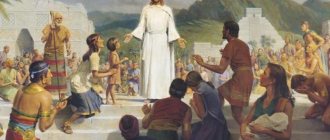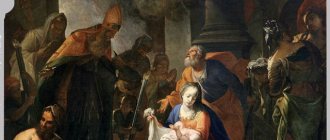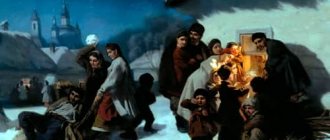Blessing Hand
This is how any bishop and priest blesses now. The hand is folded so that the Greek letters are obtained: IC XC - the first and last letters of the name “Jesus Christ”. The index finger is I, the middle finger is C, the thumb crosses with the ring finger to make the letter X, and the little finger is C. The sign is also called “Malaxa” after the Greek who described this gesture in the 16th century.
BLESSING
Double-fingered addition. Lord Almighty. Mosaic of St. Sophia Cathedral in K-pol. 2nd half XIII century
Double-fingered addition. Lord Almighty. Mosaic of St. Sophia Cathedral in K-pol. 2nd half XIII century From the NT it is known that the Lord Jesus Christ accompanied His B. with the laying on, touching or raising of hands. Monuments of the III-IV centuries. they usually talk about the laying on of hands both during the destruction of the substances of the sacraments (for example, the bread of the Eucharist) and during the destruction of people; When there was a large crowd of people, the laying on of hands was replaced by raising them. At least from the 4th century. The usual gesture during an oral priestly or episcopal blessing is to apply the sign of the cross (a cruciform movement of the hand) to the person being blessed. One of the earliest evidence of this is contained in a book compiled no earlier than the 3rd century. the apocryphal Gospel of Nicodemus (chapter 24), which describes how the Lord, who descended into hell, stretching out his hand, makes the sign of the cross on Adam and all the Old Testament saints. At the same time, for the cruciform B., different finger configurations could be used, such as an open palm (“all-finger”), and one or several. fingers.
Greek finger build. St. Gregory of Nyssa. Mosaic of St. Sophia Cathedral in Kyiv. 1037–1045
Greek finger build. St. Gregory of Nyssa. Mosaic of St. Sophia Cathedral in Kyiv. 1037–1045
The use of different forms of finger formation in B. is closely related to the gestures of Rome. orators (for example, connecting the ring finger with the thumb, when the rest are extended, meant the beginning of speech or censure (Quint. Inst. orat. 11.3), and the outstretched right hand, with the index and middle finger straightened, with the little finger pressed and the ring finger and outstretched thumb - the process of speech or threat (Apuley. Metamorphoses. 2. 21)). In addition, the ancient art of counting on fingers also had a certain influence on fingering. Holy Patriarch Herman I of Poland, in his interpretation of the Divine Liturgy (8th century), gives a numerical interpretation of the bishop's B. on the reading of the Gospel before the removal of the catechumens: the fingers of the blessing hand should depict the Greek. the letters ς and φ, which have certain numerical values and in total give 6500 - the estimated year (from the creation of the world) of the Second Coming of Christ the Savior (Herman, St. Legend. p. 67).
From the 5th century in the East, due to the particular severity of Christological disputes, the confession of faith began to be depicted on the fingers (Theodorit. Church history 2.31; Sozomen. Church history 4.28; Nicephorus Callistus. Church history 9.48): 2 connected fingers symbolize the Divine and human natures of Christ the Savior, and 3 - the Three Divine Persons. Depending on which 3 fingers are connected - the thumb, ring and little finger or the thumb, index and middle finger - two and three fingers are distinguished. The usual finger formations in the East for a long time were the connection of the thumb with the ring finger, dating back to antiquity, with the rest extended (in this case, the thumb and ring fingers depict a cross; it was this finger formation that St. Herman had in mind in his interpretation) and two fingers; both are found, for example, on mosaic icons and frescoes of the 11th century. in the St. Sophia Cathedral in Kyiv. In addition, from the 6th century. in the East, B. appears with only 4 fingers of the right hand with the thumb pressed. K ser. XVI century usual in Greek In the churches there is a nomenclature of the finger, in which the index and middle fingers are connected so that the first of them, straightened, represents the letter I, and the second, also extended and several. inclined, letter C; the thumb is coupled with the last 2 so that, crossing the ring finger, it represents the letter X with it, and the little finger, extended and spread out. inclined, - the letter C, i.e. Greek letters. alphabet Ι, Σ and Χ. At the same time, the monogram of the Savior is depicted - icxc, i.e. the first and last letters of the name IJesus Christ. Sometimes other letters were seen in such a finger formation: Ν (from ΝΙΚΑ - Victory), A and Ω (see Alpha and Omega), Τ as an image of the cross. The nominal finger formation probably goes back to the finger formation with the index, middle and little fingers straight and the thumb and ring fingers joined. To Byzantium. In icons, mosaics and frescoes depicting Christ and saints, there are also other forms of finger formation with a raised hand. The interpretation of the gesture of figures with a raised hand only as a blessing is incorrect; this gesture often indicates not B., but an appeal (Golubinsky. History of the RC. T. 2. Part 2. pp. 487-503).
Nominal finger formation. St. Pitirim Tambovsky. Icon. XX century
Nominal finger formation. St. Pitirim Tambovsky. Icon. XX century
In the Russian Church until the 16th century. Various forms of the sign of the cross were used, but in 1551 the Council of the Stoglavy introduced uniformity both for the sign of the cross and for the priestly B.: “If anyone does not bless with two fingers, as Christ did, or does not imagine the sign of the cross, let him be cursed” (Stoglav Chapter 31). The doctrine that for the sign of the cross it is necessary to use only two fingers served as one of the reasons for the schism in the Russian Church - when in 1666 the Great Moscow Council decided to use the nominal sign of the finger for the priestly sign (Acts. L. 47v., 48), “even if the Greek order would not be destroyed” (Makarii. History of the RC. T. 8. pp. 101-102), some of the believers did not accept either this or other changes proposed by the Council in Russian. liturgical customs of the beginning. XVII century and went into the Old Believer schism (the Old Believers call the name ring “malaxa” - after the Greek priest Nicholas Malaxa, who wrote an interpretation of it in the mid-16th century, included in the book “Tablet” by Patriarch Nikon (M., 1656)) . Nevertheless, the nominal sign for priestly B. was adopted in Rus' and is now used by all Orthodox Christians. Local Churches. In addition to the distinction between the sign of the sign of the cross and the sign of the cross, priestly and episcopal gestures differ: only a bishop can bless not with one, but with two hands; in his presence, priests do not bless (see Bishop's service).
Bishop's blessing
Bishop's blessing
In the West on Wed. century, the “all-finger” was preserved, which began to be interpreted as “the sign of the five wounds of Christ” (2 on the hands, 2 on the legs, 1 on the side), which healed humanity from sin (cf. Isa 53.5; 1 Peter 2.24; 1 John 1.7). Spanish Ep. Luke of Tudetan († 1288) did not distinguish between the sign of the cross and the gesture of B. (Golubtsov. From readings. pp. 247-248). From the 12th century in Greek collections of canonical rules include an anonymous article against the Latins (in the Slavic Helmsman: article “About the Friars and other Latins”), where among the main misconceptions of Catholics, the incorrect formation of the finger under B. is indicated: “Some of them somehow bless with five fingers and with a finger face is marked, like the Monothelites...” In the late Middle Ages in the West, they began to distinguish between the “Greek” finger (the thumb and ring finger are connected, and the index, middle and little finger are straightened) and the “Latin” finger (the little finger and ring finger are bent and pressed to the palm, and the thumb , middle and index fingers straightened). For the first time, the “Latin” form of B. is mentioned by Pope Leo IV (847-855): “Mark the cup and bread with the correct cross, that is, not around and somehow with your fingers, as many do, but with two fingers straightened and the thumb folded inward, through which the Trinity is signified, correctly try to depict this sign: +, for you cannot bless anything otherwise” (PL. 96. Col. 677).
For teaching B., icons and crosses are also used, and at the end of the liturgy - St. chalice with the Holy Gifts, Gospel, candles (bishop's dikiri and trikiri, Easter three-candlesticks, candle at the Liturgy of the Presanctified Gifts), sprinkling of the Holy. water, anointing with oil (for example, at the all-night vigil), etc.
Lat. finger build. The central part of the “Ghent Altarpiece”. 1432 Artists J. and H. van Eyck (Cathedral of St. Bavo in Ghent. Belgium)
Lat. finger build. The central part of the “Ghent Altarpiece”. 1432 Artists J. and H. van Eyck (Cathedral of St. Bavo in Ghent. Belgium)
Greek Since ancient times, the word εὐλογία (eulogia - B.) has been customary to call special gifts containing shrines, objects from St. places, blessed bread, etc. (A. Stubier).
I speak
The index and middle fingers are raised up, and the little and ring fingers are bent or pressed against the palm. The thumb is either simply raised up or pressed against the ring finger (yes, these are different signs for speakers, but the meanings are close, we will not separate them).
The symbol means direct speech, a moment of speech. This is the second type of gesture by the archangel on the Annunciation of the Blessed Virgin Mary icons. Those who say: this is a gesture of blessing are also right! A good word spoken is a blessing.
LiveInternetLiveInternet
This gesture of the speaker is indicated in ancient treatises on oratory. Therefore, from a very early time it was often used in Christian images when it was necessary to show a sermon, prophecy, etc. Most often it is accompanied by an image of the Gospel or a scroll in the hands of the person depicted. Or, for example, the arch. was depicted with such a gesture. Gabriel in the scene of the Annunciation, which showed his appeal to the Virgin Mary with the famous words: “Rejoice, O Joyful One, the Lord is with Thee.” Please note that the Old Testament prophets are depicted with this gesture, who could neither sign the sign of the cross nor bless like the saints. However, St. Herman of Constantinople (8th century) in his interpretation of the liturgy indicates that after reading the Gospel the saint overshadows the people with his hand with fingers folded in a similar composition. It is noteworthy that this is indicated to be done precisely after the Gospel. That is, the sign of the fingers symbolizes the gospel sermon. This sign of St. Herman interprets it not as a designation of the name of Jesus Christ, but in a completely different, rather intricate way. For considerations regarding the various finger formations that we find on ancient monuments of Christian iconography, we consider it not inappropriate to list those types of finger formations that are known to us as ordinary oratorical gestures. Quintilian describes such gestures: The small middle finger was connected to the finger (bent under the finger), the other three fingers were extended (of the two middle fingers, of course, it was the small middle one); Quintilian says about this spelling that it is the most commonly used, appropriate at the beginning of a speech, and with the further pronunciation of the latter - in narratives, censures and accusations.” (Golubinsky) Images of Christ and saints, which are usually called blessings, do not have such a meaning in reality and originate from ancient images representing orators and philosophers. The ancients loved to accompany their words with gestures; pagan orators and philosophers, before making any speeches or expounding their teachings, usually resorted to a wide variety of body movements, as if greeting their listeners, or arousing their attention. At an evening with one noble woman, Hypatia Burrea, one of the guests, according to Apuleius, beginning his story, took the following pose: having picked up the carpet on which he was sitting near him, and raising himself a little on his elbow, he raised his right hand and, following the example of the orators, , skillfully formed a gesture, bending the last two fingers to the palm, and keeping the rest free. There is nothing more common than to encounter images with this or a similar gesture in ancient painting and plastic arts. In ancient paintings, this gesture is very often supplemented by a scroll, which is held in the hands of orators, philosophers and generally learned people, and something like a tub or basket (scrinium) at their feet, with several books or scrolls. One has only to remember how many similar images are found in the catacombs when it comes to Christ as a teacher, the apostles and prophets, as preachers, to be convinced, if not of the identity, then at least of the close connection of these historical and symbolic plots and their attributes with the usual techniques of representing rhetoricians and philosophers by classical painters and sculptors. Having arisen and grown on soil saturated with the traditions of the centuries-old life of the ancient world, young Christian art, as is now well known, took advantage of everything from classical art that was possible, starting from ordinary techniques of technology to the complete assimilation of ready-made artistic models. It did not neglect the conventional gestures of pagan orators and philosophers, applying them to its own goals and putting new Christian content into forms alien to it. Golubtsov A.P. From readings on Church Archeology and Liturgics And here it is worth recalling that Christian culture in general and Christian iconography in particular did not arise out of nowhere. This is, so to speak, a “creative processing” of Hellenistic ancient culture. And the gesture we are considering is no exception. It is borrowed from the ancient oratorical tradition. Greek and Roman speakers had their own set of gestures with which they accompanied their speeches. The Roman rhetorician Marcus Fabius Quintilian writes in most detail about such gestures in his book “Admonitions to the Orator.” He talks about nine oratorical gestures, but we will select from them those that later entered Christian iconography: 1. The ring finger bends under the thumb, the rest are extended forward. This gesture is typical for the beginning of speech, as well as for narration, blame or accusation. 2. The two middle fingers are tucked under the thumb, the index and little fingers are extended forward. This is an “urgent” gesture according to Quintilian. 3. The last three fingers are folded under the thumb. The index finger is extended. This is a gesture of reprimand and direction. 4. The thumb, ring and little fingers are tucked in. The index and middle fingers are extended. In iconography we see the same thing: Thus, we can summarize that similar gestures on icons, as a rule, imply direct speech of the character or a call: “vonmi”, and not a blessing in the sense of imposing the sign of the cross. Christian historical sources also speak about this. For example, the Byzantine historian Paul the Silentiary, in his description of Sophia of Constantinople, mentions the altar curtain, on which is woven the image of the Savior, “stretching out the fingers of his right hand, like a prophetic verb, and in his left hand having a book that knows (contains) divine verbs.” In this context, for example, the gesture of the Archangel Gabriel in the Annunciation scene does not mean the blessing of the Mother of God, but the good news in the most literal sense of the word. Of course, this does not mean that Christ cannot be depicted with a blessing gesture at all. Let’s just repeat once again - any iconic symbol must be “readable” in its context. https://ateismy.net/index.php?option=com_content&view=article&id=915:lr————&catid=76:2011-01-08-18-42-21&Itemid=108
Start of speech
And also a sign of reproach. This is an ancient sign of orators. The ring finger connects to the thumb. The rest are straight forward. The most popular sign at the time. Means: “Here I begin my speech.” On the icons it is more correct to read: “I am beginning the gospel!” This is how the Archangel Gabriel is depicted when he informs the Virgin Mary that the Messiah will be born from her. This is how the hand of the Lord often looks when He “blesses” on an icon from the cloud.
If the speech continues, the sign increases the load and means censure. With such a gesture, Christ approaches the disciples who had fallen asleep in the garden.
Special attention!
This is the very sign that was appropriated by some musical movements, calling it “goat”. For ancient speakers it always meant “Pay special attention!” With this sign on the icons, Christ points to the Gospel in His hand, calling to heed the Good News. Who knows, maybe in the first centuries the priest showed just such a sign before reading the Gospel at the Liturgy? But in our time we only hear the loud: “Wisdom, let us hear!” The hand can be turned and the palm facing us. When the apostles hold their hands like this, it can be interpreted as defending the truth of the Christian faith, persistent preaching.
Sign of Reproof
When only the index finger is raised up, and the rest are pressed against the palm, this is a sign of direction and reprimand. This is how the prophets who came to denounce the people, as well as the accusers of Christ, are sometimes depicted. This is also how Peter points to his head on the “Washing of the Feet” icon with the meaning: “Not only the head, but also the feet.”
Just as in life, by some gestures, we can guess about a person’s feelings and thoughts, so a canonical icon, if we know how to understand its symbols, vividly conveys to us the thoughts and feelings of the saints.
January 9, 2020
ANOTHER GESTURE OF BLESSING
Two fingers are raised up (index and middle), the thumb, ring and little fingers form three fingers. This is how Old Believers are baptized now. This is how people began to be baptized when heresies appeared that denied the divine nature of Christ or denied the Holy Trinity. As you understand, two fingers together tell us about the two natures of the Messiah, that He is God and man. And three fingers symbolize the Father, Son and Holy Spirit. Over time, this gesture turned into the familiar Sign of the Cross, when the little and ring fingers are pressed to the palm, and the other three are pressed into a pinch. The meaning remains the same.
It seems to me that the symbol is similar to a name addition. Perhaps the icon painters themselves wanted the gesture to contain several meanings. What do you think?










